Scott Splawn tells how his four-person operation evolved from modding his own plexis to customizing stock Marshalls as a dealer and finally to building “brown sound” wonders for players like Steve Stevens and prolific metal producer Adam Dutkiewicz.
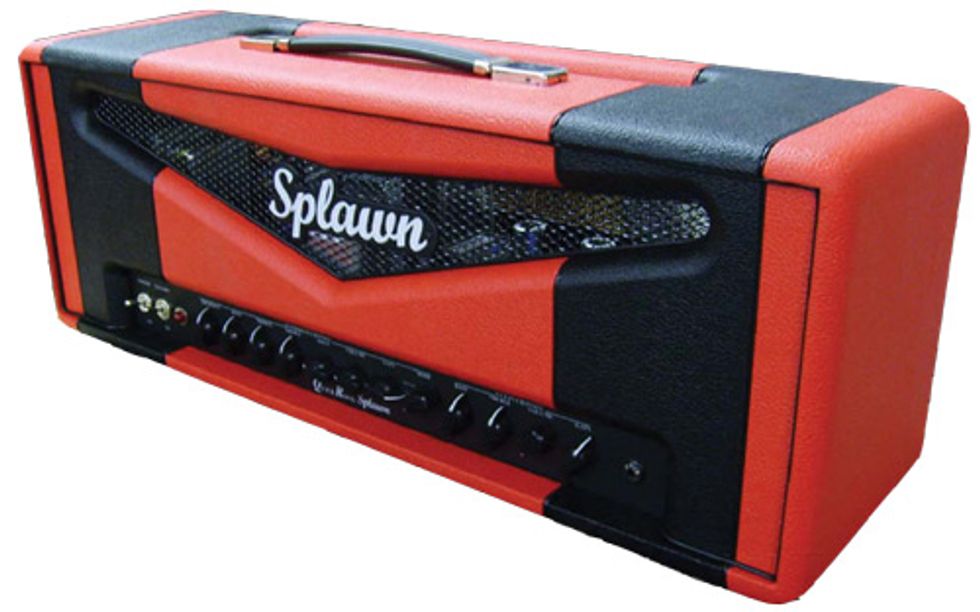
Splawn’s most popular amp, the 2-channel, 100-watt Quick Rod, is voiced for hot-rodded ’80s
tones, and its overdrive channel features Hot Rod Plexi, Hot Rod 800, and Super Hot Rod 800 modes.
Splawn developed his designs by modding old and new Marshall amps and learning through trial and error how these legendary heads could be made even more crushing and versatile—all while running his own music store, Splawn Guitars, and gigging extensively with local bands.
For the past six years, Splawn and a small crew have been making killer amps—mostly in the head-and-cabinet style—all by hand from start to finish. These flexible amps have earned some high-profile devotees, including Steve Stevens, Dokken’s Jon Levin, and Killswitch Engage’s Adam Dutkiewicz.
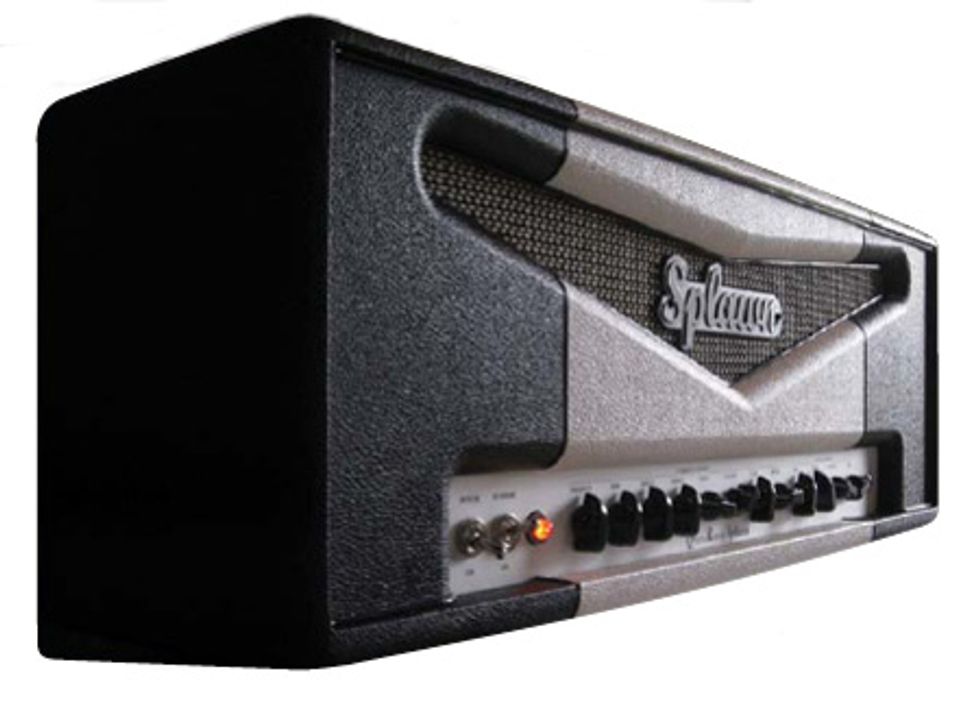
Splawn amps are available in a variety of racing-themed coverings,
as shown by this black-and-white-striped Quick Rod.
Splawn’s amp shop is behind the storefront of his eponymous guitar boutique, which is crammed with axes by Charvel, ESP, and other metal-approved makers—instruments perfectly suited for his aggressive stacks. While the guitar world at large has been catching on to Splawn amplifiers, many of the store’s local visitors are completely unaware of what’s going on in back. “A lot of customers have never even heard of our amplifiers,” says Splawn.
We recently chatted with Splawn to learn more about the genesis and evolution of his amps, which, given the company’s growing league of enthusiasts, certain North Carolinians will likely learn more about soon.
How did you get into modifying amplifiers?
In the mid ’90s, I opened Splawn Guitars, where I sold instruments and did repair work on stringed instruments. I wanted to also be able to work on tube amps, so I studied up on them by reading how-to and electronics books. This gave me a decent knowledge of how amps work and how to repair them. Then I started doing mods on some of my own old Marshalls, to give them some extra gain. As I was working on an amp, I’d take it to rehearsals and gigs—I played in a bunch of cover bands and Christian rock groups—to see how it worked in context. By experimenting I learned to make the best-sounding mods I could. Once I got my customized amps sounding like I wanted, I took them to the shop, where customers would check them out and then bring in their own gear for me to mod.
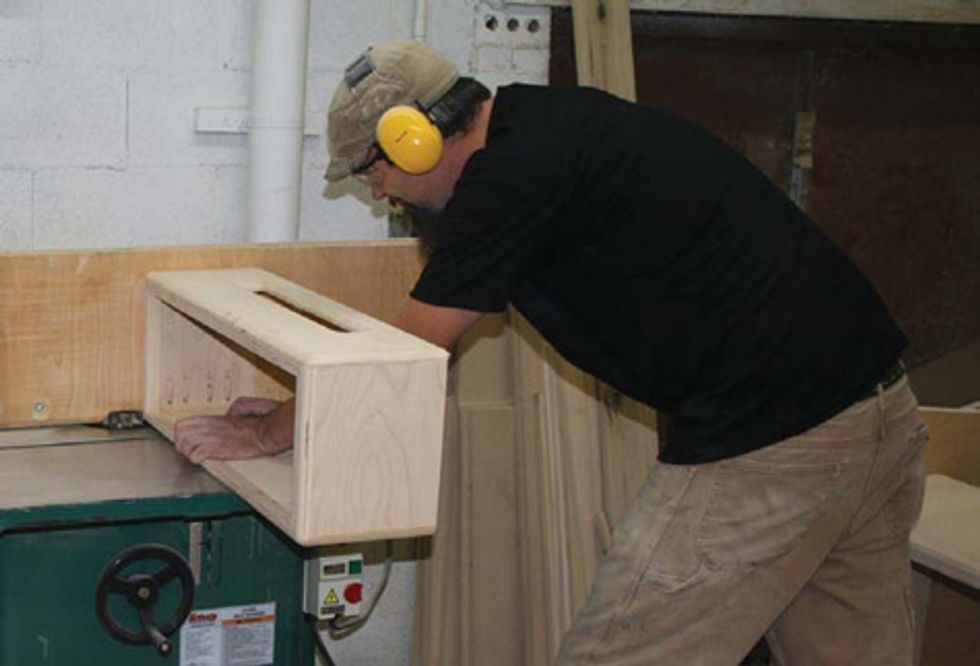
Cabinetmaker Brian Smith routes the edge of a Splawn head.
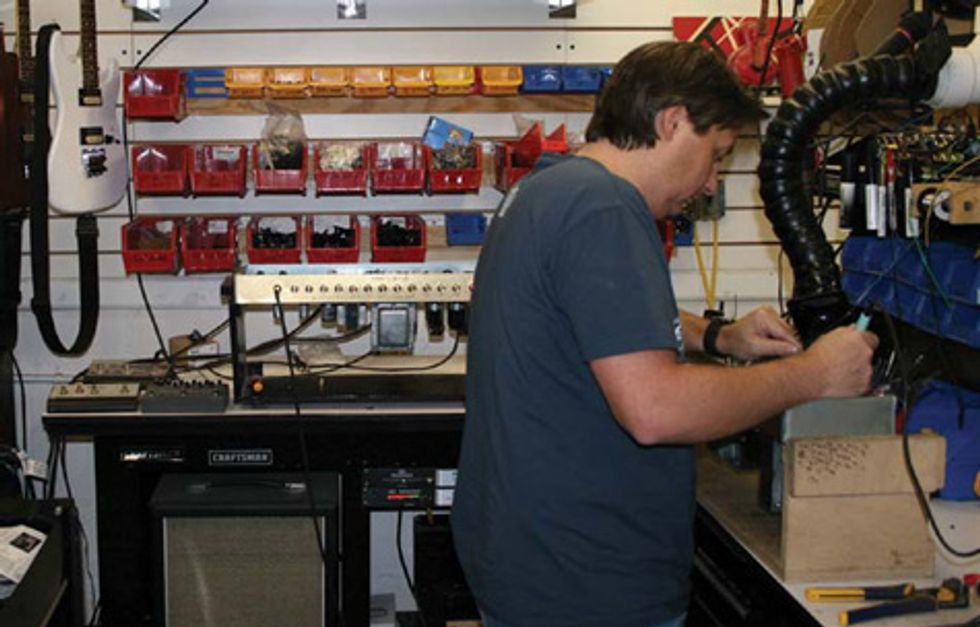
Owner and founder Scott Splawn works inside one of his amp chassis.
What sort of mods did you provide?
My most common mod involved completely rewiring the preamp to an all-tube, four-gain stage, which made for lots of headroom, rich harmonics, and sustain. Some customers also wanted things like a half-power switch, an effects loop, and a footswitchable solo boost—mods that would make their amps a bit more versatile.
How’d you get your name out there in the beginning?
A couple of customers put audio clips of my modded amps on internet forums, and that’s when I started getting calls from people all over wanting to send me their amps for updating. Some players wanted to get the sound of one of my modded amps, but didn’t have any equipment to send me, so I started to buy used amps on eBay to modify and resell. But after awhile I ran into a problem where I could no longer find amps at the right price to justify modding them, so I ended up getting hooked up as a Marshall dealer. Since I got the amps at cost, I’d take a couple of different brand-new models— the 1959SLP and JCM800 reissues— modify them, and sell them for the same price that other dealers sold standard new Marshalls.
When and why did you go from modding amps to building them?
In the early 2000s, Marshall had a pretty substantial price increase, and that turned some customers off. So, I started sourcing out parts and building my own amps from scratch. The first amps with my name on them came out in 2004.
Are all your amps all-tube?
They’re absolutely all-tube. Some other makers use diode-clipping distortion in their amps, but I find that all-tube distortion has a more organic feel, with greater harmonic content.
What components go into a Splawn amp?
When I first started modding amps, I went through a lot of different brands of capacitors and resistors to find the components that sounded best to my ear. I don’t want to give away our brands, but I use the same parts in my own amps. We’ve stuck with all the same components since we started to try to keep the amps as consistent as possible. We don’t cut any corners. It doesn’t matter if they go up in price, we just have to keep using what we know to be the best parts we can get our hands on, since they contribute so much to the sound. I also use Heyboer transformers. They’re the secret weapon—most of my tone comes from those transformers, and they’re also a great company to do business with.
Are your circuit boards point-to-point or printed?
Our amps feature both types of circuit board. From years of doing mods, I’ve learned that to get the sound I want, all of the critical gain stages have to be point-to-point. But for some of the switching circuits, power sections, etc., we use printed circuit boards, which don’t detract from the tone and are a lot more durable out there in the field. Printed circuit boards can also save a lot of time—something that’s crucial when your operation is as small as mine.
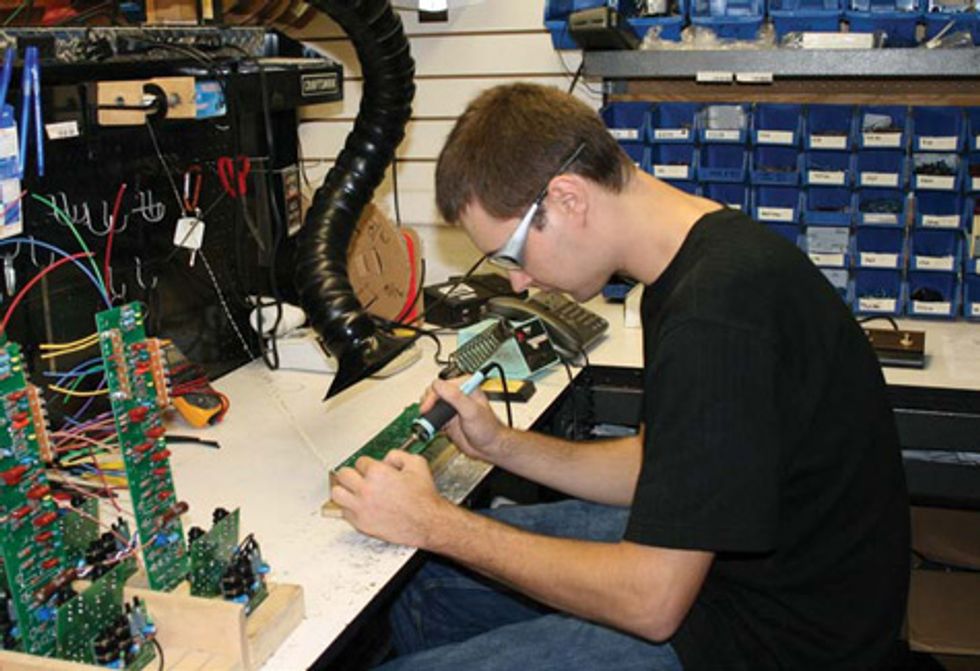
Electrical tech Josh Mauldin solders a PC board.
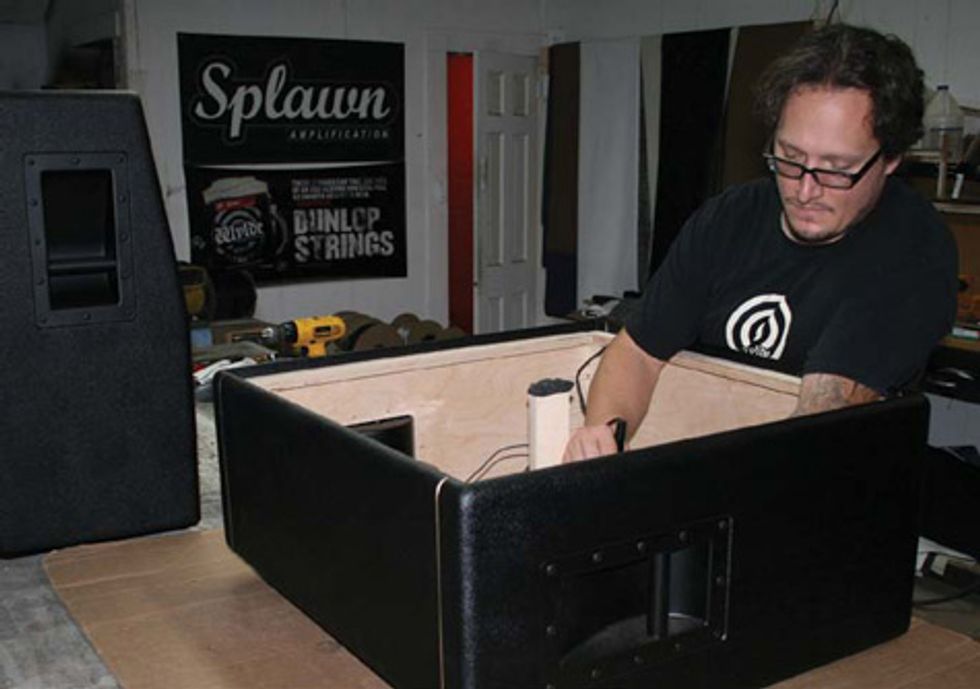
Brian Einsiger wires a 4x12 cab after having applied the Tolex covering.
How small is your shop?
Four people, including myself—the same crew since the beginning. I have one guy who helps me in the shop, stuffing and soldering the boards. I do the rest of the wiring, all by hand, and test the amp through the burn-in process—all of which takes me about six hours of work per amp. And I’ve got two guys in our shop’s cabinet section: one who does the woodworking and another who does the finishing work with Tolex.
How many total hours go into making a Splawn?
It’s difficult to say, since we’re four people working on different amps at the same time, but I would estimate that about 12 hours of work go into each amp, cabinet included. It takes us so long because we don’t use any amp kits. Everything’s done by hand, and all of the sockets and switches are chassis mounted—there’s nothing board mounted. It’s a time-honored technique that’s worked really well for us. We seldom hear about problems with our amps.
So how many amps do you average per week?
Around five or so.
Would you ever consider selling Splawn amp kits to those who’re electronically inclined?
No, because of the liability involved and also, to do it right, I’d want to be available to answer any questions that customers might have about assembling their kits. Between designing and building the amps and all of my other responsibilities, like paying bills and ordering parts, unfortunately I don’t have the time for that.
What’s it been like to work in North Carolina, a great distance from any major music city?
It feels good, since it’s where I grew up and where I got started playing music and working on amps. The cost of living is pretty low, so I don’t have to worry about overhead like some makers do. But it is hard being away from the big scene—I don’t have the advantages I might in a place like LA, where there’d be big-name players dropping in all the time. And, being such a small company, it’s not feasible at this point for me to go to a trade show like NAMM. I can’t afford the time away from the shop, because we’re constantly backlogged.
Speaking of the Carolinas, home to so many auto sports, your amps all have names evocative of cars.
Yes, all my amp model names come from drag racing. I’ve always been into that sport. My older brother did it for a long time and that left quite an impression on me. I also see a connection between hot-rodded amps and drag cars: both are very loud and powerful machines.
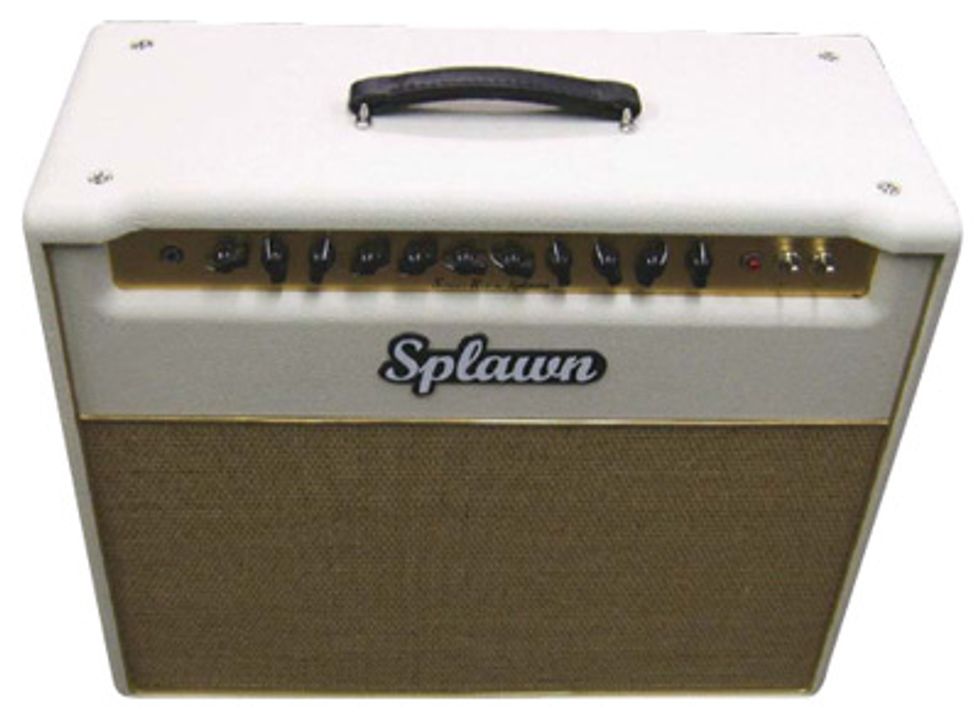
The 40-watt Street Rod is a combo version of the Quick Rod
that features a 12" Eminence Small Block speaker.
Tell us more about the whole product line.
All of our amps are based on the same Marshall head-and-cabinet platform that got me noticed in the first place. Our first amp was called the Quick Rod, and it’s our most popular model to this day. It’s a 100- watt, 2-channel, hot-rodded ’80s-sounding amp. The overdrive channel has three positions, which I call Gears, to go along with the automotive theme. There’s first gear, Hot Rod Plexi; second gear, Hot Rod 800; and third gear, Super Hot Rod 800. On all the amps, there are footswitchable lead and rhythm sounds, and a solo boost with its own Volume control.
A newer amp of ours is called the Nitro. It’s basically set up the same way as the Quick Rod, but voiced to have more low end, more gain, and less midrange to suit the modern metal player. A lot of guitarists have been asking for smaller versions of our amps, so we recently came out with the Street Rod—basically, a 40-watt combo version of the Quick Rod with a single 12" speaker. It has been really well received. Our other amps, such as the Competition and the Pro Stock, are basically just stripped-down, single-channel versions of the Quick Rod and the Street Rod.
What types of new amps do you envision adding to the line?
We’re currently working on a new type of multi-channel head, as well as some combo versions of various amps.
I noticed that none of your amps have any effects.
We don’t do any effects. We just make straight-up amps and aim to get the best raw sound we can. We don’t want players to be stuck with whatever effects we put in an amp. But since so many guitarists these days use outboard processing for electronic sounds, we put effects loops in our amps.
How would you describe that “best raw sound”?
It’s got a lot of midrange. It cuts through the mix really well. It’s very dynamic, and it reacts sensitively to different pickups, guitars, and speakers. What you put into a Splawn amp is what you get out. If you play hard, it’ll growl at you. If you lighten up, it’ll obey you. When you roll your guitar’s volume knob back on the overdrive channel, the sound cleans up really well. Splawn amps have definitely got their own thing going on—they don’t sound like anything else.
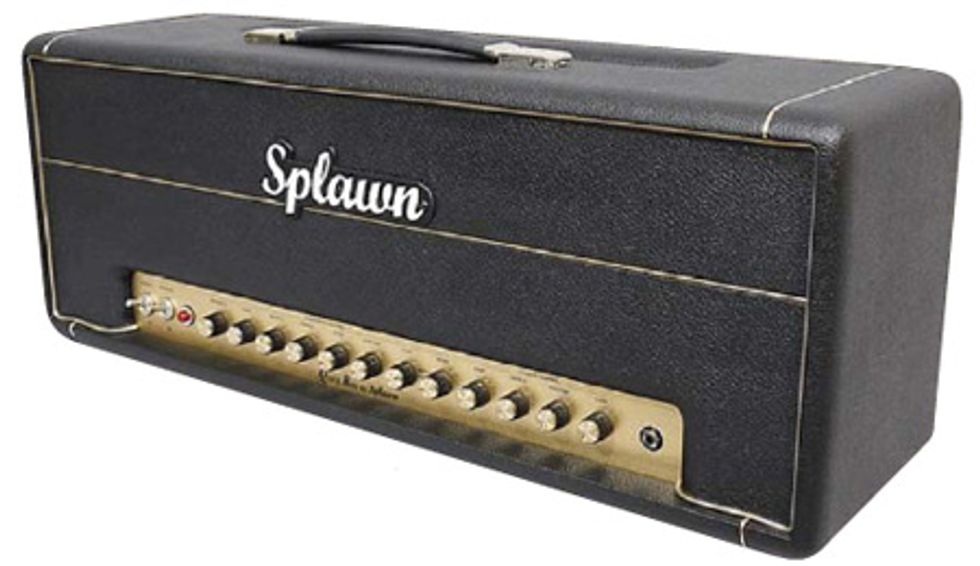
This incarnation of the Splawn Quick Rod features classic plexi styling.
What sorts of players are Splawn amps geared toward?
While we’ve got guitarists of all styles using our amps, they’re designed with the heavier player in mind. The Quick Rod, for instance, is ideal for copping the sort of sound that someone like Eddie Van Halen, George Lynch, or Warren DeMartini had in the 1980s. But any of our amps will work for a more modern sound as well. Tony Rombola of Godsmack, for instance, has recorded with both a Nitro and a Quick Rod.
Have you redesigned your amps at all based on player input?
Yes. Once our amps caught on, we learned that a lot of players didn’t actually get to use them for what they were designed for—loud music in big spaces. So we’ve made the amps more manageable at lower volumes for guitarists who play in smaller clubs or even just at home. To do that, we’ve made a very small adjustment—we added a volume control on the effects loop.
How do you feel about amp modeling?
It has come a long way in the last few years, but to my ear there’s still nothing out there that comes close to replicating the responsiveness and harmonic content of a real tube amplifier. I’m not saying there won’t be, there just hasn’t been anything yet. There’s still nothing like a tube amp, and I hope for our sake it stays that way.


